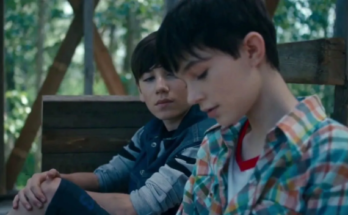Fifty Shades Freed (2018)
Fifty Shades Freed is the third and final installment in the Fifty Shades film series, based on E.L. James’s best-selling book trilogy. This romantic drama continues the tumultuous love story between Anastasia Steele (Dakota Johnson) and Christian Grey (Jamie Dornan), as they navigate the complexities of married life, overcoming dark secrets, personal struggles, and external threats. The film, filled with steamy moments, emotional highs and lows, and intense drama, aims to bring a satisfying conclusion to the saga that captivated millions.

Plot Summary: The film begins shortly after the wedding of Anastasia and Christian, showcasing the newlyweds embarking on their honeymoon. Christian’s dark past, however, still looms over their relationship, as his former lover, Elena Lincoln (Kim Basinger), is not done with him yet. She continues to cause trouble for the couple, leading Anastasia to confront her fears about Christian’s complicated relationship with his former dominant.
Despite their efforts to build a life together, Anastasia’s career is also in a constant balancing act with Christian’s world of business and power. She becomes involved in a new project at work, while Christian must deal with a series of challenges to his family empire. As the movie progresses, both characters face deeper challenges that test their trust in each other, as well as their ability to fully let go of their pasts. The plot moves toward a final confrontation with the forces trying to tear them apart, leading to a climactic and emotional resolution for their relationship.

Artistic Analysis: Visually, Fifty Shades Freed follows the same sleek, polished aesthetic that the franchise has become known for. The cinematography takes full advantage of the luxurious settings—from expansive homes to exotic vacation spots—capturing the opulence of Christian and Anastasia’s world. The color palette is rich, with warm golds, deep reds, and moody blues that reflect the intense emotions and romance between the couple.
The film also makes use of sweeping shots and intimate close-ups to emphasize the passion and vulnerability of the characters. While the film continues to showcase its trademark sensuality, it also explores more tender and heartfelt moments, particularly between Christian and Anastasia, as they navigate their evolving dynamic.
The soundtrack plays a crucial role in setting the tone, featuring a mix of contemporary hits and emotional ballads that mirror the shifts in the characters’ relationship. The music accentuates key moments, whether it’s the soaring melodies during romantic scenes or the intense, driving rhythms during moments of conflict.

Performances: Jamie Dornan’s portrayal of Christian Grey continues to be both compelling and conflicted. While his character has softened compared to the first film, Dornan still manages to bring the necessary intensity to Christian’s persona—his mixture of vulnerability and dominance remains central to the character’s appeal. In this final installment, Christian is seen grappling with the idea of control in a marriage and dealing with his own insecurities, and Dornan effectively captures the nuances of this internal conflict.
Dakota Johnson’s performance as Anastasia is equally strong, showing her character’s growth from the shy, uncertain woman we met in the first film to a more confident, assertive partner who is learning how to navigate her relationship with Christian. Johnson brings warmth, empathy, and strength to Anastasia, making her journey of self-discovery and empowerment feel authentic and relatable.
The supporting cast also delivers solid performances, particularly Kim Basinger as the manipulative Elena Lincoln. Basinger adds a layer of complexity to the character, portraying her not only as a foil to Anastasia but also as a woman who, in her own way, still has unresolved feelings for Christian.

Emotion: At its core, Fifty Shades Freed is about trust, forgiveness, and the complexities of a relationship that moves beyond passion into real partnership. The film explores the challenges of maintaining a marriage while facing past mistakes and external pressures. The emotional tension between Christian and Anastasia is palpable as they wrestle with their pasts—Christian’s troubled history with Elena and Anastasia’s fears of being controlled and overshadowed.
There are also moments of deep personal growth for both characters. For Anastasia, it’s about coming into her own—finding her voice and asserting her independence, while still loving and supporting Christian. For Christian, it’s about letting go of the emotional baggage that has haunted him and trusting in Anastasia to be his partner in every sense of the word.
The film touches on themes of personal healing and the challenges of maintaining a healthy relationship under pressure. While it deals with issues of power dynamics, jealousy, and control, the ultimate focus is on the strength of their bond and the realization that love, at its best, is built on mutual respect, understanding, and acceptance.

Final Thoughts: Fifty Shades Freed serves as a satisfying conclusion to the Fifty Shades series, wrapping up the emotional arcs of its two protagonists. It offers a mix of passion, drama, and resolution, providing fans with the long-awaited conclusion to Anastasia and Christian’s tumultuous love story. While it may not break new ground in terms of storytelling, it stays true to the themes that have made the series so popular—exploring the complexities of love, trust, and the fight for personal freedom within a relationship.
The film is an emotional ride that balances steamy romance with deep emotional beats, making it a fitting end for the saga. Fans of the franchise will find Fifty Shades Freed to be a satisfying conclusion that answers lingering questions and provides closure for Christian and Anastasia’s journey.



